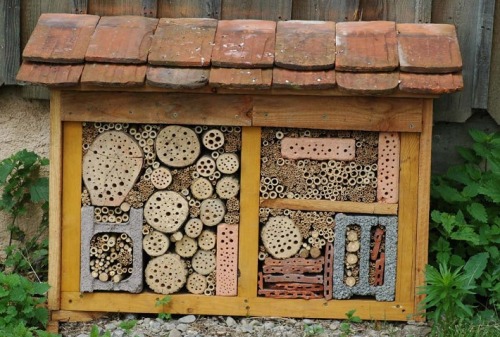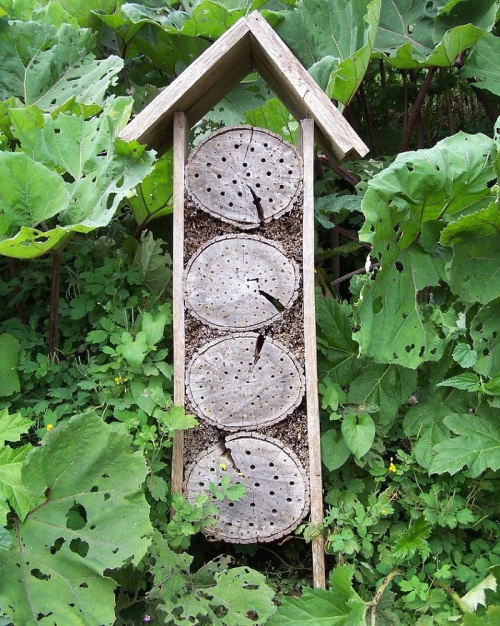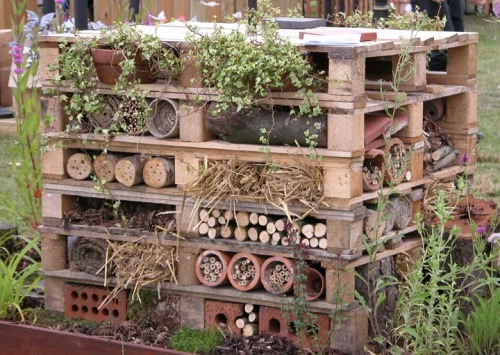Follow Us On Instagram Too: Https://www.instagram.com/yup.that.exists

Follow us on Instagram too: https://www.instagram.com/yup.that.exists
More Posts from Copperfingertips and Others



I’m using a plant to catch a leak in the ceiling. “No such thing as waste in a permaculture system,” right?






Insect Hotels
Over 30% of solitary bee species are wood nesters, some spending up to nine months of their lives as larvae incubating in forest deadfall. Ladybugs hibernate over winter in stacks of twigs, and other beneficial creatures – like wasps, lizards, moths, hedgehogs, beetles, and dragonflies – love to find little nooks and crannies to hide from predators and the elements, at any time of year.
An insect hotel is ideally placed in a sheltered location, but still in the sunlight. Ants sometimes eat bee larvae, so a solitary bee hotel is best placed off of the ground. Often, a wire mesh is placed on the outside to prevent bird predation. Ideally, the surrounding area should host flowering and insectary plants, to provide food for the guests!
These natural habitats are often missing from a domestic or overly-landscaped garden, and are absolutely vital to the health of your plants, local life web, and for the pollination of your garden. Designing for your native wildlife is crucial for a long-term healthy, productive, and sustainable space. Good, ecologically-minded design also minimises the amount of work you have to do: for example, I find that when I practice companion planting with insectary Apiaceae-family plants, I never have an aphid problem, because predatory beetles abound, and they eat problematic insects before they get established. Creating balanced ecosystems is a form of biological pest control.
An insect hotel is easily made from twigs, wood, tiles, pinecones, bricks, bark, grass, and other natural or salvaged materials. The form can differ, depending on what sort of creatures you would like to attract, and your aesthetics, but it should basically be designed from a “bug’s eye” view of the world: research what your local species are and what they require in terms of a habitat, and then create it for them in a manner that appeals to your eye.
These are also excellent projects for kids: they are fun and easy to make, interesting to observe, and help foster an early understanding of biology and ecology.
#DIY #bees #insects #entomology #biomimicry #permaculture #kids #art
Pre-made insect hotels: North America / Europe
Images:
B. Alter - Royal Bank of Canada New Wild Garden at the Chelsea Flower Show
sav-überlingen.de
Sissi de Kroon, flickr.com
Insect hotel in Hoofddorf, Holland. Bob Daamen, flickr.com
Cheshire Wildlife Trust, cheshirewildlifetrust.org.uk
Kevin Smith and Lisa Lee Benjamin. floragrubb.com
Inspiration Green Article on Insect Hotels
Everyone should garden
Sometimes when I’m talking to people about sustainability they’re like, “well, not everyone wants to garden” and it’s like, on the one hand I’m sure that’s true because of the diversity of the human experience means that someone out there would hate gardening no matter what.
But on the other hand…. what???? Why would someone NOT want to experience the miracle of life and then have the freshest ingredients possible to cook with??? All while releasing no green house gasses and being super cheap???
Humans have literally lived forever surrounded by plants with cultivating plants as a vital part of how we have lived for thousands of years and you’re telling me that we should stop doing that because some people don’t like to garden??
Gardening isn’t a hobby! It’s a way of life that we all need to be living if we can because our current way of life is unsustainable! Also everyone that can garden should so we can support the people who can’t. Gardening is what made us human and we can’t stop now.

Researchers at Michigan State University have created a fully transparent solar concentrator, which could turn any window or sheet of glass (like your smartphone’s screen) into a photovoltaic solar cell. Unlike other “transparent” solar cells that we’ve reported on in the past, this one really is transparent, as you can see in the photos throughout this story. According to Richard Lunt, who led the research, the team are confident that the transparent solar panels can be efficiently deployed in a wide range of settings, from “tall buildings with lots of windows or any kind of mobile device that demands high aesthetic quality like a phone or e-reader.”

Matt Zeilinger, Solarpunk Girl (portrait of Krishna Jaya)

~ the pondering muse🌙
I know I’ve written about this a lot in the past month but this article has some new tidbits about mushroom’s beneficial effects on soil remediation. Apparently, not only can mushrooms break down plastics, radioactivity, generate electricity, and a plethora of other things. But it can also remove pesticides, dyes, remnants of explosives in the soil, and act as a stimulant for biofuel conversion! Pretty interesting stuff isn’t it?



The lavender held memories, the eucalyptus remembered all the tears, and the poppies were always there to see the years crawl by.
Three plants that are reminders of my childhood home in Northern California.
Inprnt Shop
Etsy
Patreon

I didn’t do the inktober this year, but I had fun with a tiny house :3
-
 emeralddoom liked this · 2 months ago
emeralddoom liked this · 2 months ago -
 panther-of-the-lilies liked this · 4 months ago
panther-of-the-lilies liked this · 4 months ago -
 yingtai-is-reading reblogged this · 5 months ago
yingtai-is-reading reblogged this · 5 months ago -
 yingtai-is-reading liked this · 5 months ago
yingtai-is-reading liked this · 5 months ago -
 windymarshfens liked this · 5 months ago
windymarshfens liked this · 5 months ago -
 affableadversary liked this · 6 months ago
affableadversary liked this · 6 months ago -
 lily-lumine liked this · 7 months ago
lily-lumine liked this · 7 months ago -
 talonlily reblogged this · 9 months ago
talonlily reblogged this · 9 months ago -
 talonlily liked this · 9 months ago
talonlily liked this · 9 months ago -
 utensil-ace liked this · 9 months ago
utensil-ace liked this · 9 months ago -
 zoroslove reblogged this · 10 months ago
zoroslove reblogged this · 10 months ago -
 euxinia liked this · 10 months ago
euxinia liked this · 10 months ago -
 thetwinarmageddons reblogged this · 10 months ago
thetwinarmageddons reblogged this · 10 months ago -
 thetwinarmageddons liked this · 10 months ago
thetwinarmageddons liked this · 10 months ago -
 waywardtricksterfox liked this · 11 months ago
waywardtricksterfox liked this · 11 months ago -
 silverdragonazura liked this · 1 year ago
silverdragonazura liked this · 1 year ago -
 thepaleopatrol liked this · 1 year ago
thepaleopatrol liked this · 1 year ago -
 kylawashere22 liked this · 1 year ago
kylawashere22 liked this · 1 year ago -
 ransomnoteworthy liked this · 1 year ago
ransomnoteworthy liked this · 1 year ago -
 ill-d0-it-later reblogged this · 1 year ago
ill-d0-it-later reblogged this · 1 year ago -
 theblackdandelion liked this · 1 year ago
theblackdandelion liked this · 1 year ago -
 moistletoe liked this · 1 year ago
moistletoe liked this · 1 year ago -
 hail-americas-ass liked this · 1 year ago
hail-americas-ass liked this · 1 year ago -
 nyxenyo reblogged this · 1 year ago
nyxenyo reblogged this · 1 year ago -
 nyxenyo liked this · 1 year ago
nyxenyo liked this · 1 year ago -
 onlyknownothing liked this · 1 year ago
onlyknownothing liked this · 1 year ago -
 snoodly-boop reblogged this · 1 year ago
snoodly-boop reblogged this · 1 year ago -
 snoodly-boop liked this · 1 year ago
snoodly-boop liked this · 1 year ago -
 yenoodlethings reblogged this · 1 year ago
yenoodlethings reblogged this · 1 year ago -
 la-clementina reblogged this · 1 year ago
la-clementina reblogged this · 1 year ago -
 red-will reblogged this · 1 year ago
red-will reblogged this · 1 year ago -
 what-a-stupid-lamb liked this · 1 year ago
what-a-stupid-lamb liked this · 1 year ago -
 thngrn20 liked this · 1 year ago
thngrn20 liked this · 1 year ago -
 alirina-and-her-cat liked this · 1 year ago
alirina-and-her-cat liked this · 1 year ago -
 rainbowcold liked this · 1 year ago
rainbowcold liked this · 1 year ago -
 nerdy-shy-readytocry liked this · 1 year ago
nerdy-shy-readytocry liked this · 1 year ago -
 consultingcriminal reblogged this · 1 year ago
consultingcriminal reblogged this · 1 year ago -
 meissama liked this · 1 year ago
meissama liked this · 1 year ago -
 liqhtwood liked this · 1 year ago
liqhtwood liked this · 1 year ago -
 reallyinitnow liked this · 1 year ago
reallyinitnow liked this · 1 year ago -
 fishermansalsa reblogged this · 1 year ago
fishermansalsa reblogged this · 1 year ago -
 wingmant reblogged this · 1 year ago
wingmant reblogged this · 1 year ago -
 drhoz liked this · 1 year ago
drhoz liked this · 1 year ago -
 triangleofdog reblogged this · 1 year ago
triangleofdog reblogged this · 1 year ago







